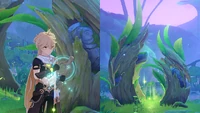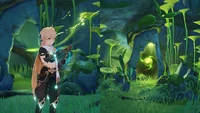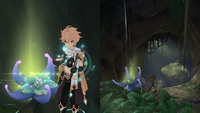Vintage Lyre is a gadget that can be obtained during the World Quest The World of Aranara. Throughout the Aranyaka Quest Series, more songs will be unlocked along with new functionality.
The lyre has a range from C3 to B5. It has flats according to C Dorian for the bottom and middle rows (C3 to B4 with flats on E3, B3, E4, and B4) and C Phrygian for the top row (C5 to B5 with flats on D5, E5, A5, and B5). Notes are labeled with solfège syllables rather than note names, with C as do. Multiple notes can be played simultaneously, but notes cannot be held, as expected of a plucked instrument.
Usage[]
Like other Music Gadgets, the Vintage Lyre can be used to play music. In addition, playing particular songs unlocked by the Aranyaka quest series can activate multiple Exploration mechanics in Sumeru. If the player has not unlocked the required song, then the "Aranara Score not yet mastered..." will appear.
| Song | Unlock Requirement | Effect |
|---|---|---|
| Rhythm of the Great Dream | Complete The World of Aranara |
|
| Rhythm of Vamadha | Progress through Vimana Agama: Royinjan's Chapter | Activate Vamadha |
| Rhythm of the Gloomy Path | Progress through The Rhythm that Leads to the Gloomy Path | Awaken Gloomy Paths |
| Rhythm of the Beastly Trail | Progress through The Rhythm that Reveals the Beastly Trail | Cause certain obstacles near Claustroflora to disappear |
| Rhythm of the Sprout | Progress through The Rhythm that Nurtures the Sprout | Summon Healthy Dendrograna near Sprouting Branches used to revive Valaya |
| Rhythm of the Source Water | Complete A Prayer for Rain on the Fecund Land | Change the weather in the Apam Woods near Varuna Contraption |
| Rhythm of Revival | Complete Starry Night Chapter | Repair broken Elemental Monuments |
Tutorial[]
- The power of music...
 Use the Vintage Lyre in the forest to play songs with mysterious power and realize their special effects. That said, these songs share a relationship of correspondence to certain objects. You will have to match the appropriate songs to the right objects for this to work out.
Use the Vintage Lyre in the forest to play songs with mysterious power and realize their special effects. That said, these songs share a relationship of correspondence to certain objects. You will have to match the appropriate songs to the right objects for this to work out.Use the Vintage Lyre in the forest to play songs with mysterious power and realize their special effects. That said, these songs share a relationship of correspondence to certain objects. You will have to match the appropriate songs to the right objects for this to work out.
- Strange Arch...
 These strange arches are known as Phantasmal Gates. Complete the challenges within, and perhaps something good will happen.
These strange arches are known as Phantasmal Gates. Complete the challenges within, and perhaps something good will happen.Play Arana's song on the Vintage Lyre in front of a Phantasmal Gate to awaken it. After this, enter the arch to undertake the challenges.
These strange arches are known as Phantasmal Gates. Complete the challenges within, and perhaps something good will happen.
Play Arana's song on the Vintage Lyre in front of a Phantasmal Gate to awaken it. After this, enter the arch to undertake the challenges.
 During a challenge, you must collect all the Phantasmal Seeds and return to the Phantasmal Gate within the time limit. If you are hit by attacks from opponents during this time, the time allotted to you for the challenge will decrease...
During a challenge, you must collect all the Phantasmal Seeds and return to the Phantasmal Gate within the time limit. If you are hit by attacks from opponents during this time, the time allotted to you for the challenge will decrease...During a challenge, you must collect all the Phantasmal Seeds and return to the Phantasmal Gate within the time limit. If you are hit by attacks from opponents during this time, the time allotted to you for the challenge will decrease...
 After you have entered the Phantasmal Gate, certain special Dream Flowers will appear. Standing within the barrier that these flowers project will cause opponents to forget your existence and allow you to exit combat. Additionally, activating these Dream Flowers with Electro will allow them to mark the location of the remaining Phantasmal Seeds for you, but this will also undo the effect of the barrier.
After you have entered the Phantasmal Gate, certain special Dream Flowers will appear. Standing within the barrier that these flowers project will cause opponents to forget your existence and allow you to exit combat. Additionally, activating these Dream Flowers with Electro will allow them to mark the location of the remaining Phantasmal Seeds for you, but this will also undo the effect of the barrier.After you have entered the Phantasmal Gate, certain special Dream Flowers will appear. Standing within the barrier that these flowers project will cause opponents to forget your existence and allow you to exit combat. Additionally, activating these Dream Flowers with Electro will allow them to mark the location of the remaining Phantasmal Seeds for you, but this will also undo the effect of the barrier.
- Rhythm of Revival
 Aranakin's song. It can be used to awaken the life within the plants around you and borrow that strength to join some broken stone structures together.
Aranakin's song. It can be used to awaken the life within the plants around you and borrow that strength to join some broken stone structures together.Even stones that were once blessed will split and crack given time. But Aranakin's song can reawaken the wood and mend these broken structures.
Aranakin's song. It can be used to awaken the life within the plants around you and borrow that strength to join some broken stone structures together.
Even stones that were once blessed will split and crack given time. But Aranakin's song can reawaken the wood and mend these broken structures.
- Rhythm of Vamadha
 Ararycan taught you this song. It has the power to turn Vamadha.
Ararycan taught you this song. It has the power to turn Vamadha.Judging from how the Vamadha look, you could say that they confirm the legend that "plants dance to music" on some level.
Ararycan taught you this song. It has the power to turn Vamadha.
Judging from how the Vamadha look, you could say that they confirm the legend that "plants dance to music" on some level.
- Rhythm of the Gloomy Path
 The song that Araji left behind. It can awaken the Gloomy Path in the woods and open new paths.
The song that Araji left behind. It can awaken the Gloomy Path in the woods and open new paths.According to Arayasa, Araji is very timid and enjoys hiding in quiet places.
As such, the song that he left behind has the power to unlock trails that lead to secret sites.
The song that Araji left behind. It can awaken the Gloomy Path in the woods and open new paths.
According to Arayasa, Araji is very timid and enjoys hiding in quiet places.
As such, the song that he left behind has the power to unlock trails that lead to secret sites.
- Rhythm of the Beastly Trail
 The song that Arayama left behind. If you play it to Claustroflora, you can cause certain obstacles to disappear.
The song that Arayama left behind. If you play it to Claustroflora, you can cause certain obstacles to disappear.It is said that Arayama used to hate humans and so used illusions to thwart them, but that he would ultimately meet a human friend because of those illusions.
The only song he left behind is one that can remove obstacles. As to whether a song that can create them is still hidden in the forest somewhere is unclear...
The song that Arayama left behind. If you play it to Claustroflora, you can cause certain obstacles to disappear.
It is said that Arayama used to hate humans and so used illusions to thwart them, but that he would ultimately meet a human friend because of those illusions.
The only song he left behind is one that can remove obstacles. As to whether a song that can create them is still hidden in the forest somewhere is unclear...
- Rhythm of the Sprout
 The song Aramaha left behind. If you play it to Sprouting Branches, you can summon Healthy Dendrograna that can then be used to revive Valaya.
The song Aramaha left behind. If you play it to Sprouting Branches, you can summon Healthy Dendrograna that can then be used to revive Valaya.Aramaha was known for a great love of flowers, but the idea of using flowers to hide songs is said to have been Arayama's.
The song Aramaha left behind. If you play it to Sprouting Branches, you can summon Healthy Dendrograna that can then be used to revive Valaya.
Aramaha was known for a great love of flowers, but the idea of using flowers to hide songs is said to have been Arayama's.
- Rhythm of the Source Water
 Arapandu taught you this song. It has the power to control the Varuna Contraption.
Arapandu taught you this song. It has the power to control the Varuna Contraption.According to Arapandu, the Varuna Contraption once turned the black rain into sweet rain, bringing life to the forest.
Performing this tune will cause the Varunastra to activate or deactivate. However, you should probably be more conscientious in its use.
After all, Aranakula do not like too much rain, as it will impede the growth of plants. Arakunti also said before that "too much rain makes the mushrooms difficult to cook."
Arapandu taught you this song. It has the power to control the Varuna Contraption.
According to Arapandu, the Varuna Contraption once turned the black rain into sweet rain, bringing life to the forest.
Performing this tune will cause the Varunastra to activate or deactivate. However, you should probably be more conscientious in its use.
After all, Aranakula do not like too much rain, as it will impede the growth of plants. Arakunti also said before that "too much rain makes the mushrooms difficult to cook."
- Rhythm of the Great Dream
 Arana's song.
Arana's song.Play it to Silapna to enter and exit dreamscapes.
You would certainly like to call them "stones with strange markings on them"... But if you think about it, you've seen way too many stones with odd marks, so you might as well just use the term Arama used, "Silapna."
According to Araja, Aranara songs all possess their unique character. As such, if you hear the song, you will know whose it is.
Arana's song.
Play it to Silapna to enter and exit dreamscapes.
You would certainly like to call them "stones with strange markings on them"... But if you think about it, you've seen way too many stones with odd marks, so you might as well just use the term Arama used, "Silapna."
According to Araja, Aranara songs all possess their unique character. As such, if you hear the song, you will know whose it is.
Disclaimer[]
There is a disclaimer in-game regarding the use of the lyre:
- When using the Performance function, please make sure that you use an original composition or have the relevant rights to use the melody you are playing in order to avoid harming the rights of any third parties and to avoid any actions in breach of or incompatible with our Terms of Service. Otherwise, we may have to restrict your use of this function.
Additionally, the content you perform can be heard and used by other players using this in-game function. Please read and confirm that you acknowledge the aforementioned stipulations.
Trivia[]
- The solfège syllables are incorrectly labeled for the notes with flats, as do-based minor uses chromatic solfège syllables for the notes that are different from those of the major scale. The correct syllables are:
- Top row: do ra me fa so le te
- Middle row: do re me fa so la te
- Bottom row: do re me fa so la te
- The lyre utilizes three clefs (or pitches) and two Indian ragas (frameworks) for the scale. The treble clef uses the Raag Bhairav structure and the alto/bass clefs uses the Raag Kafi structure. The Raag Bhairav is a morning raga that is said to be the first raga to originate from the mouth of Lord Shiva . The Raag Kafi is known as the Bhairavi (Kundalini, mother goddess/coiled snake) of night and is suitable for songs of both separation and union.
Other Languages[]
| Language | Official Name | Literal Meaning |
|---|---|---|
| English | Vintage Lyre | — |
| Chinese (Simplified) | 老旧的诗琴 Lǎojiù de Shīqín | Old Lyre |
| Chinese (Traditional) | 老舊的詩琴 Lǎojiù de Shīqín | |
| Japanese | 古びたライアー Furubita Raiaa | Old Lyre |
| Korean | 낡은 하프 Nalgeun Hapeu | Old Harp |
| Spanish | Lira antigua | Old Lyre |
| French | Lyre ancienne | Old Lyre |
| Russian | Старинная лира Starinnaya lira | Old Lyre |
| Thai | พิณเก่าแก่ Phin Kao-kae | |
| Vietnamese | Đàn Cổ | |
| German | Alte Leier | Old Lyre |
| Indonesian | Vintage Lyre | — |
| Portuguese | Lira Antiga | |
| Turkish | Klasik Lir | Classic Lyre |
| Italian | Lira vintage | Vintage Lyre |
Change History[]
[]
| ||||||||||||||








































































































